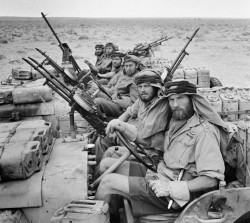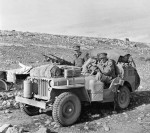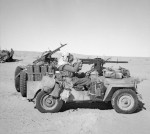Special Air Service
Contributor: Alan Chanter
 The Special Air Service (SAS) was the brainchild of Lieutenant David Stirling, who came up with the idea for a specialist team of saboteurs while recovering in hospital following a parachuting accident. Successfully placing his plans directly before General Neil Ritchie at HQ Middle East he was, commanded to recruit six officers and sixty men for a training course in the Suez Canal Zone and to prepare for a raid on Axis airfields on the night before a major offensive. This was accompanied with an immediate promotion to captain.
The Special Air Service (SAS) was the brainchild of Lieutenant David Stirling, who came up with the idea for a specialist team of saboteurs while recovering in hospital following a parachuting accident. Successfully placing his plans directly before General Neil Ritchie at HQ Middle East he was, commanded to recruit six officers and sixty men for a training course in the Suez Canal Zone and to prepare for a raid on Axis airfields on the night before a major offensive. This was accompanied with an immediate promotion to captain.
The operation, unfortunately, went badly wrong. The drop was made in the midst of a ferocious storm in November 1941, at the start of Operation Crusader, saw many men scattered or injured in landing accidents. Only 26 men came back having failed utterly in their mission. Nonetheless, Stirling remained convinced that due to the mechanised nature of desert warfare a small team of highly trained soldiers, with the advantage of surprise, might be able to attack several targets in a single night. He therefore decided that in future the SAS raiders would drive far out into the desert, often accompanied by the Long Range Desert Group, to find their targets.
Stirling's force would fight by its own rules. Shortly before Christmas 1941, Paddy Mayne, a vast Irish rugby-player with an explosive temper, and his team crept into Tamit airfield, on the Libyan coast, and planted time-bombs on twenty-four Axis aircraft. As they were withdrawing, Mayne spotted a hut with a light coming from under the door and heard a party going on inside. He and two troopers armed with tommy guns kicked open the door and opened fire. At least thirty German and Italian pilots were killed. Even Stirling was shocked, reprimanded Mayne for what he called an "over-callous execution in cold blood".
Life expectancy could be short for the early SAS. They soon established a reputation for conducting hit and run raids that left the enemy in a state of permanent befuddlement. Erwin Rommel, himself, would describe Stirling as "The Phantom Major". If they managed to survive a raid they still faced being spotted in the desert by German planes and attacked from the air. Lieutenant Jack Lewes, an Oxford educated officer with movie star looks, and his men were caught in the open by a German Stuka and dive-bombed. A 20-millimetre shell smashed through his thigh and severed the femoral artery. He bled to death in minutes and was buried in the sand. His remains have never been found.
Corporal Jack Sillito was blowing up part of Libya's Tobruk railway when his unit was attacked by a German patrol. Separated from the rest of the men he decided to walk back 180 miles across the desert to his camp. He had a revolver, compass and a small flask of water which ran out on the second day. He began to store and drink his own urine. On the fourth day his feet cracked open and his tongue swelled. Then he began to hallucinate. A week after setting off, a SAS jeep spotted a "skeleton with sore and bleeding feet", just a few miles from the camp. Stillito's arrival was close to miraculous. Within a fortnight, Stirling observed, he had "completely recovered".
In another astonishing story, Sergeant Bob Lilley was escaping on foot after a failed raid when he ran into a lone Italian soldier cycling across the desert. The 20-year-old Italian declared Lilley his prisoner. Lilley did not agree and the two men began fighting hand-to-hand, with the British sergeant eventually strangling his captor. In Special Forces jargon, a "Boblilley" is still used to describe a Commando hit-and-run operation.
The SAS was constantly under threat from senior officers, many of whom regarded Stirling's raiders as an undisciplined mob, carrying out a form of warfare that should have been left to spies and saboteurs. Many wanted the unit disbanded but Winston Churchill stepped in to save the regiment after his son, Randolph, took part in a daring raid and reported back to his father about the shadowy team. General Bernard Montgomery also came to appreciate Stirling's unit. He said: "The boy Stirling is mad, quite, quite mad. However, in war, there is often a place for mad people."
Captain Carol Mather was captured by the Italians in Tripolitania on 20 December 1942. He was transferred to Italy by submarine, and spent nine months as a prisoner-of-war in Northern Italy. He escaped in September 1943, shortly after the Italians agreed an armistice with the Allies, and walked 600 miles down the Apennines to the Allied lines near Naples. Stirling was also captured by German forces in January 1943. After four escape attempts he was eventually sent to the notorious "escape-proof" Colditz castle. However, the SAS would survive with Lieutenant-Colonel Paddy Mayne as its new commanding officer. Horrifically there was also had a spy among SAS prisoners-of-war. An undercover fascist named Theodore Schurch, infiltrated groups of SAS prisoners by posing as an inmate himself and extracting vital information that led to scores of deaths. Schurch was hanged after the war, the only British soldier to be executed for treason.
As it happened this elite force would soon be called upon for further action. In April 1943 the unit was split into two, 250 men under Paddy Mayne became the newly formed Special Raiding Squadron (SRS) tasked with attacking the battery at Capo Murro Di Porco on Sicily, while the remaining 150 men, under Major George Jellicoe became the Special Boat Squadron (SBS) for a diversionary raid on Sardinia. After several months of intensive training in Palestine which included strenuous 45-mile route marches and amphibious landings in LCAs from HMS Ulster Monarch, Mayne's men conducted their final exercise, a mock attack on a British anti-aircraft battery which was carried out with considerable success. On 10 July 1943, the Allied landings on Sicily (Operation Husky) got underway. The SRS landed at the northern most section of the British beaches on the island's east coast, and nearest to Syracuse. Paddy Mayne divided the Squadron into three troops to assail the 60 feet high sheer rocky cliffs to eliminate the coastal battery situated there. To the west, where the cliffs were less steep, No. 3 Troop was to clamber up the rocks and cut the road to the west of the battery. Captain Harry Poat's No. 2 Troop would land, hurry inland and attack from the north, while Major Bill Fraser's No. 1 Troop further to the right would head straight towards the battery supported by Captain Alec Muirhead, in charge of the mortars who would set up between in road and the battery, Mayne's plan was to confuse the enemy by suggesting that they were being attacked from multiple directions. The operation went almost without a hitch, only No. 2 Troop had landed in the wrong place, and by 0520 hours the Italian battery had been taken, prisoners rounded up and the guns destroyed; all without a single SRS man killed.
In September 1944 the SAS was enlarged to Brigade strength under the command of Brigadier Michael "Mad Mike" Calvert who had been evacuated to Britain on medical grounds (ironically following an accidental injury). In addition to 1SAS the Brigade included the 2SAS (founded in North Africa in 1943), plus the 2nd and 3rd Free French Regiment de Chasseurs Parachutistes, the Belgian Special Forces Group and "F" Squadron - responsible for signals and communications. In April 1945 Calvert's force was committed to Operation Amherst whose task was to assist the Resistance in disrupting enemy troop movements in East Holland. On the night of 7/8 April 1945, 684 lightly-armed SAS from the two French squadrons parachuted into East Holland where, despite many sticks becoming scattered, were quickly in action, ambushing German troops and wrecking bridges and railway lines. The 280 man Belgian squadron equipped with armoured jeeps was held in reserve with the Canadian 2nd Corps ready to support the French should the Canadians fail to relieve them within 72 hours. The French had dropped with only five days rations, but some soldiers were still fighting after eight days. French casualties on this operation amounted to 29 killed, 35 wounded and about 15 remained missing.
SAS men were among the first Allied troops to enter the notorious Bergen-Belsen concentration camp where more than 70,000 prisoners had perished. When they arrived in April 1945 the bodies of 13,000 lay scattered around the site with thousands more dying. Then one listless SS guard began beating up a prisoner. Warrant Officer Class 1 Reg Seekings, the foul-mouthed one-eyed boxer from Cambridge with a gift for killing without hesitation or remorse, asked for permission to "teach the guard a lesson." A former regimental boxing champion, Seekings felled the German guard with one blow When the man staggered back to his feet, Seekings knocked him down again. This time he did not get up. Given how many SAS had been killed at the hands of the SS, some of the men wanted to exact bloody revenge. Instead, they were ordered to round up the guards, compel them to bury the dead, and then arrest them.
In October 1945, Michael Calvert's SAS Brigade was disbanded but a small team survived, unofficially, as the SAS War Crimes Investigation Team, to track down the SS men who had killed their comrades. They spent three years gathering evidence and finding the graves of slain SAS men. The leader of this covert unit, Major E. E. "Bill" Barkworth, was even reported to have used an Ouija board to try to track the killers.
The SAS, which still exists today, was revived in 1947, becoming the blueprint for Special Forces around the world. Its motto embodies Stirling's whole philosophy: "Who Dares Wins."
Sources:
Ben Macintyre: "Cowboy. One-eyed boxer, and parachuting priest... meet the original SAS" (The Sun, 24 September 2016)
Rupert Butler: Hand of Steel (Hamlyn Paperbacks, 1980)
James Holland: Sicily '43 (Bantam Press, 2020)
Brigadier Michael Calvert: Operation Amherst (War Monthly)
Last Major Update: Dec 2022
Photographs
 |  |  |  |
Please consider supporting us on Patreon. Even $1 per month will go a long way! Thank you. Please help us spread the word: Stay updated with WW2DB: |

- » Evergreen Museum and Obon Society Working on Returning Undelivered 1945 Mail to Japanese Families (5 Sep 2025)
- » Wreck of Teruzuki Found (27 Jul 2025)
- » USS Orlean's Bow Found (22 Jul 2025)
- » The Emperor of Japan Planned to Honor WW2-era Japanese POWs in Mongolia (4 Jul 2025)
- » US State Lawmaker John Winter Caught Using Racial Slur "Jap" and Apologized (11 Jun 2025)
- » See all news
- » 1,183 biographies
- » 337 events
- » 45,159 timeline entries
- » 1,249 ships
- » 350 aircraft models
- » 207 vehicle models
- » 376 weapon models
- » 123 historical documents
- » 261 facilities
- » 471 book reviews
- » 28,445 photos
- » 365 maps
Winston Churchill, 1935
Please consider supporting us on Patreon. Even $1 a month will go a long way. Thank you!
Or, please support us by purchasing some WW2DB merchandise at TeeSpring, Thank you!